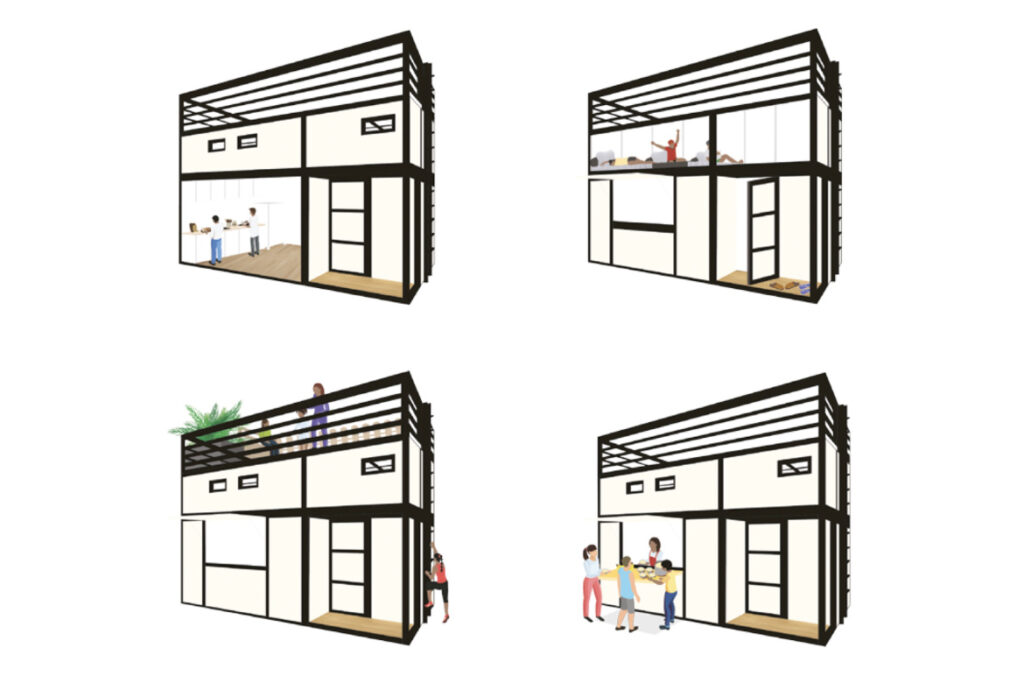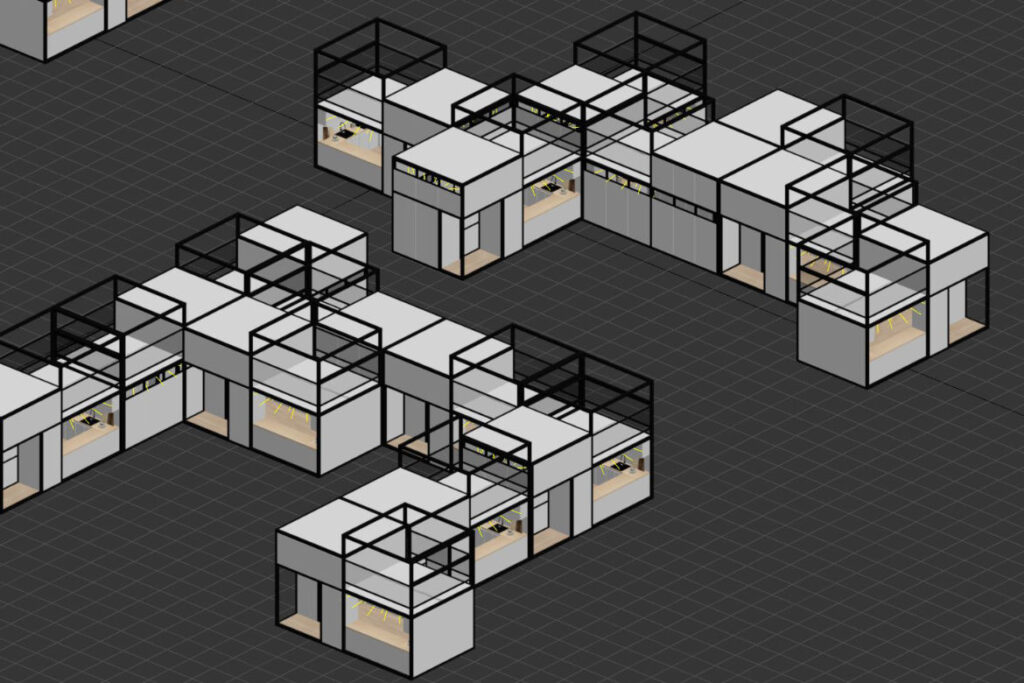How do we design and provide better living conditions for the marginalised in urban cities? We hear from The CHA Project, JIA Studios and The Shelter Company on how Doonya could be a game changer.

From left, Samuel Vedanaigam (CEO of The Shelter Company), Rinkoo Bhowmik (Founder of The CHA Project) and Jackie Lai (Founder of JIA Studios). Photography by Juliana Tan.
March 7th, 2022
Vanitha Pavapathi (VP) Let’s start by talking about the genesis and concept of Doonya, a modular, full-facility, solar-powered shop and home designed to improve the lives of those living in informal settlements around the world.
Rinkoo Bhowmik (RB) Doonya is both a social enterprise and a solution born from an urban regeneration plan for India’s only surviving Chinatown initiated by my company, The CHA Project which is based in Singapore. The idea was to transform Kolkata’s Chinatown into an economically vibrant, clean and sustainable arts-heritage-food hub with its own unique identity. Jackie came on board to design the food streets and we found problems in its implementation as the streets were occupied by informal settlements which have to be displaced. Eviction was never on our minds, but when an Indian government official made a seemingly innocuous statement to clear the squatter settlements, I knew that it would push the squatters deeper into poverty. We had to find a solution that put the voiceless first and Doonya was conceived to replace existing makeshift homes.
Jackie Lai (JL) Doonya draws inspiration from the success of Singapore shophouses, in which the former operates as a shop by day and a home by night. It is designed to support a home business, be it a tea stall, a mini mart, a tailoring unit or even a childcare centre. This preserves the vibrancy of an informal settlement but removes the squalor. Initially, we explored prefab concrete as the construction material but quickly realised that it is difficult to transport.

RB So I continued my search for temporary structures. The biggest turning point was meeting Samuel of The Shelter Company, the man behind the proprietary Tubelar® Modular System. His built-in-a-day system changed the game for Doonya. And he is just as passionate about social housing, having built an emergency hospital in earthquake-ravaged Bohol, Philippines in 2013.
VP Can you tell me more about the Tubelar® technology and how it is adopted for Doonya?
Samuel Vedanaigam (SV) It’s a patented and fully accredited technology encompassing engineering and cutting-edge design to provide turnkey shelter solution that adheres to Design for Manufacturing and Assembly (DfMA) method of construction. This means Doonya can be built in eight hours by four people using just one Allen key – no special skills required. It is limited to two storeys but can be expanded horizontally to accommodate larger families. The lightweight and highly customisable modular shop and home can be quickly assembled, dismantled, flat-packed and moved to different locations. Each component weighs no more than 25 kilograms yet the entire structure is earthquake-proof.
RB Informal settlements are usually dark, squalid, overcrowded places. By using the Tubelar® Modular System to construct Doonya, we are able to create low-cost, transient homes that open up to sunlight and fresh air. There’s a roof terrace on each unit, which could be used as an urban farm to supplement the family’s food needs.
SV Once our pilot intervention in Kolkata takes off, our aim is to change the world one home at a time. By bringing together like-minded people across the industry, we’re certain that Doonya is the solution to homelessness and low-cost housing. It could also circumvent the social housing backlog in overcrowded cities.
JL Instead of uprooting pavement dwellers from their places of work, the area can be rebuilt in a more systematic manner. Doonya helps residents re-design their own neighbourhood using unit aggregation expertise from Singapore University of Technology (SUTD). These aggregations create community spaces for residents while maximising the number of Doonya units facing a street in order to attract more business.

VP Where else do you plan to implement Doonya?
SV We are speaking to the government bodies in Bangladesh, Philippines, Indonesia and Rwanda for their buy-in.
RB Our modus operandi is to approach government bodies, World Bank and Asian Development Bank to acquire Doonya units for the marginalised in overcrowded cities.
VP How else is Doonya different from other low-cost temporary housing structures?
RB Doonya is a transient solution that needs no land rights as governments would lease the units for a fixed period, thereby preventing eviction. Each unit will be Wi-Fi-enabled wherever feasible and fitted with a built-in alarm that notifies neighbours or police should domestic violence occur. It will also have a unique GPS address that gives residents an identity, making it easier to apply for bank loans to start a business. Should the resident relocate, the address will still be tagged to the resident. This special feature could potentially contribute to the population census. We’re even roping in business students to educate and set up Doonya residents up for success in their businesses.
SV The land value is relatively low in an informal settlement but it would increase with Doonya shop and home community because the neighbourhood would become clean and attractive. Surrounding neighbourhoods would also become more desirable with the absence of squatter homes.
VP Doonya seems like a simple solution to a complex problem that can bring about a paradigm shift in attitude towards building more inclusive cities.
SV That’s what we’re hoping for. We are very fortunate to be supported by passionate individuals and organisations that want to make a difference. Arup, a global advisory firm supports Doonya as a consultant; Singapore University of Technology (SUTD) lends its expertise in sustainable design science and architectural design; and Project SHEA comes up with community engagement strategies and human-centric technologies. Doonya is a social enterprise that is growing bigger each day and we’re still seeking for more corporate support so we could help make housing for all a reality.

jiastudios.com
thesheltercompany.com
thechaproject.com
A searchable and comprehensive guide for specifying leading products and their suppliers
Keep up to date with the latest and greatest from our industry BFF's!

Elevate your outdoor spaces with pieces that are beautiful, functional, and engineered for you.

XTRA celebrates the distinctive and unexpected work of Magis in their Singapore showroom.

Following its successful inaugural event in early 2024, the Vietnam International Trade Fair for Apparel, Textiles, and Textile Technologies (VIATT) is gearing up for its next instalment in 2025.

With the exceptional 200 Series Fridge Freezer, Gaggenau once again transforms the simple, everyday act of food preservation into an extraordinary, creative and sensory experience, turning the kitchen space into an inspiring culinary atelier.

In this episode of Stories Indesign podcast, Timothy Alouani-Roby speaks to Greens MP and spokesperson for housing and homelessness, Max Chandler-Mather.

This upcoming panel will examine the role of digitalisation in sustainable architecture with a focus on housing.
The internet never sleeps! Here's the stuff you might have missed

This chair makes flexible working easier than ever, thanks to intelligent engineering and human centred design.

The Man x Machine x Material collaboration by Jarrod Lim and The American Hardwood Export Council explores how generative AI can enhance design processes while also revealing the areas where human intuition remains irreplaceable.